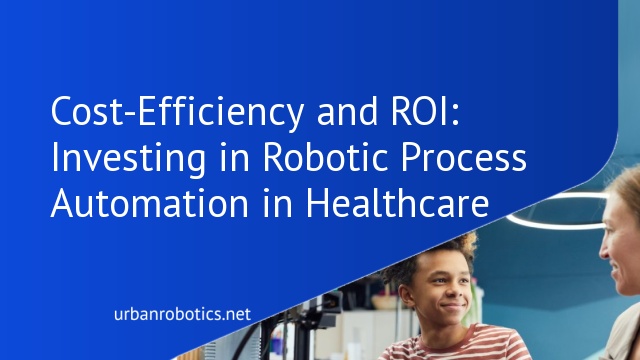Today, healthcare providers are uniquely positioned to achieve a competitive market advantage by using automation to manage complex data. According to a Fortune Business Insights report, the global Robotic Process Automation (RPA) market will grow from $14 billion in 2022 to $50 billion by 2030. RPA can reduce costs accumulated through wasteful steps, manual intervention, human error, and billing office backlogs. It can also increase appointment turnaround by automating patient scheduling and reminders, improving resource utilization and employee satisfaction.
The Benefits of RPA in Healthcare
RPA (Robotic Process Automation) in healthcare offers numerous benefits, revolutionizing the industry by streamlining processes and improving efficiency. By leveraging automation, healthcare organizations can achieve cost-efficiency and a high return on investment (ROI) while enhancing the overall patient experience.
One of the key advantages of RPA in healthcare is increased productivity. By automating repetitive and time-consuming tasks such as claims validation, denial management, and remittance posting, healthcare professionals can focus more on patient care. This increased productivity leads to reduced errors and faster reimbursement, ultimately improving the financial stability of healthcare organizations.
In addition to productivity gains, RPA enables seamless integration of health data from different sources. This enhanced data interoperability allows for better decision-making and more comprehensive patient care. By automating data extraction and validation, healthcare organizations can ensure accurate and up-to-date information, leading to improved outcomes.
Improved Efficiency and Enhanced Financial Performance
RPA also plays a crucial role in streamlining healthcare processes. By automating tasks like patient scheduling and reminders, claims validation, and adjudication, as well as patient payment processing and collections, healthcare organizations can significantly reduce manual work and achieve greater efficiency. This streamlining of processes not only saves time but also enhances revenue cycle performance, accelerating reimbursements and optimizing the financial performance of healthcare organizations.
| Benefits of RPA in Healthcare | Description |
|---|---|
| Increased Productivity | RPA automates repetitive tasks, allowing healthcare professionals to focus more on patient care. |
| Enhanced Data Interoperability | RPA enables the seamless integration of health data from various sources, improving decision-making and patient care. |
| Streamlined Processes | Automating tasks such as patient scheduling, claims validation, and payment processing reduces manual work and improves efficiency. |
| Improved Financial Performance | RPA accelerates reimbursements and optimizes the financial stability of healthcare organizations. |
Key Considerations for Implementing RPA in Healthcare
Implementing Robotic Process Automation (RPA) in healthcare requires careful planning and consideration. To ensure a successful integration of RPA into the healthcare workflow, there are key factors that need to be addressed:
Scalability and Flexibility
When implementing RPA in healthcare, scalability and flexibility are crucial considerations. The RPA system should be able to adapt to the growing volume and complexity of revenue cycle activities. As healthcare organizations expand, the RPA solution should be capable of handling increased workloads without compromising performance and efficiency.
Integration Capabilities
Integration capabilities are also important when implementing RPA in healthcare. The RPA solution should be compatible with existing electronic health record (EHR), billing, and claims administration systems. Seamless integration ensures that data can be exchanged efficiently between different systems, allowing for streamlined processes and improved data interoperability.
User-Friendly Design
A user-friendly design is essential for successful RPA implementation in healthcare. Non-technical users should be able to easily create and manage automation workflows. Intuitive interfaces and tools simplify the process of setting up and modifying automation processes, empowering healthcare professionals to leverage RPA technology without requiring extensive programming knowledge.
Security and Compliance
Security and compliance are paramount in healthcare. When implementing RPA, it is crucial to ensure that sensitive patient information remains protected. The RPA solution should adhere to industry standards and regulations, including data encryption, access controls, and audit trails. By implementing robust security measures, healthcare organizations can ensure the privacy and confidentiality of patient data.
Analytics and Reporting
Analytics and reporting capabilities are valuable for process improvement and analyzing the return on investment (ROI) of RPA implementation. The RPA solution should provide insights into process performance, allowing for continuous optimization and identification of areas for improvement. By leveraging data analytics, healthcare organizations can make data-driven decisions and maximize the benefits of RPA in revenue cycle management.
Implementing RPA in healthcare requires strategic planning and considerations of scalability, integration, user experience, security, and analytics. By addressing these key considerations, healthcare organizations can leverage the power of RPA to streamline processes, improve efficiency, and enhance the overall revenue cycle management.
Key Use Cases of RPA in the Revenue Cycle
Robotic Process Automation (RPA) offers numerous benefits to the revenue cycle in healthcare. By automating various tasks, RPA streamlines processes, reduces manual work, and improves overall efficiency and accuracy. Let’s explore some key use cases of RPA in the revenue cycle:
Claims Management
RPA can significantly enhance claims management by automating processes such as claims validation and adjudication. By extracting data from incoming claims, RPA can validate the information against predefined rules, ensuring accuracy and reducing the need for manual intervention. Additionally, RPA can identify and flag potential errors or discrepancies, improving the overall quality of claims processing. This leads to faster reimbursement, reduced claim denials, and improved revenue cycle performance.
Denial Management
RPA can play a crucial role in automating denial management processes, which are often time-consuming and prone to human error. With RPA, healthcare organizations can automate the identification and analysis of denied claims, allowing for quicker resolution and resubmission. By streamlining denial management, RPA helps healthcare providers improve their revenue cycle efficiency, minimize revenue leakage, and increase cash flow.
Remittance Posting and Reconciliation
RPA can automate the time-consuming and repetitive task of remittance posting and reconciliation. By extracting data from remittance advice documents and matching them with corresponding claims, RPA can accurately post payments and reconcile discrepancies, reducing the manual effort required. This not only enhances accuracy but also speeds up the process, ensuring timely updates to patient accounts and improving overall revenue cycle efficiency.
| Use Case | Benefits |
|---|---|
| Claims Management | Reduced claim denials |
| Denial Management | Improved revenue cycle efficiency |
| Remittance Posting and Reconciliation | Enhanced accuracy and timeliness |
These are just a few examples of how RPA can revolutionize the revenue cycle in healthcare. By automating manual tasks and optimizing processes, RPA helps healthcare organizations improve financial performance, enhance patient satisfaction, and drive overall operational efficiency.
Overcoming Challenges in Healthcare with RPA
The healthcare industry faces numerous challenges that can hinder efficient operations and quality patient care. However, Robotic Process Automation (RPA) offers promising solutions to overcome these obstacles and drive positive transformation in the healthcare sector.
Disruption in the Healthcare Industry
The healthcare industry is experiencing significant disruption from new players and evolving technologies. RPA can help healthcare organizations adapt to this changing landscape by streamlining processes, reducing costs, and improving operational efficiency. With RPA, repetitive and time-consuming tasks can be automated, freeing up valuable resources and enabling staff to focus on higher-value activities, such as patient care and strategic decision-making.
RPA in Staffing
Staffing shortages continue to pose a challenge in the healthcare industry, impacting patient care and organizational performance. RPA can alleviate this burden by automating tasks that traditionally require extensive manpower. By leveraging RPA, healthcare organizations can optimize staffing resources, improve productivity, and ensure that healthcare professionals can concentrate on critical and specialized areas.
RPA in Healthcare Challenges
Implementing RPA in healthcare also addresses other industry challenges, such as rising healthcare costs and lengthy approval and licensing processes. RPA streamlines workflows and reduces manual errors, leading to cost savings and faster turnaround times. Additionally, RPA enables better data interoperability, allowing healthcare organizations to integrate data from various sources and make informed decisions for improved patient outcomes and operational efficiency.
| Challenges | RPA Solutions |
|---|---|
| Rising healthcare costs | Cost savings through process automation |
| Disruption in the healthcare industry | Streamlining processes and improving operational efficiency |
| Staffing shortages | Optimizing staffing resources through task automation |
| Lengthy approval and licensing processes | Reducing turnaround times and improving efficiency |
As the healthcare industry continues to evolve, embracing RPA can unlock numerous benefits and help organizations navigate the challenges they face. By leveraging automation, healthcare providers can enhance patient care, streamline operations, and drive positive change across the entire healthcare ecosystem.
The Future of Healthcare with RPA and Digital Transformation
As the healthcare industry continues to evolve, the integration of advanced technologies like Robotic Process Automation (RPA) will play a significant role in shaping the future of healthcare. RPA, along with digital transformation, is poised to revolutionize the way healthcare organizations operate, delivering improved efficiency, accuracy, and patient care.
With the implementation of RPA, healthcare providers can expect to see innovations such as virtual health services, advanced data analysis, and enhanced interoperability between systems. These advancements will enable personalized and value-based healthcare, meeting the changing needs of patients and providers alike.
RPA will also contribute to the emergence of secure data platforms and care institutions focused on health and wellness. By automating manual tasks and streamlining processes, RPA will optimize health and care delivery models, ensuring that healthcare organizations can provide cost-effective and high-quality services.
RPA in Healthcare Future
The future of healthcare lies in harnessing the power of RPA and digital transformation. By embracing these technologies, healthcare organizations can overcome challenges, drive innovation, and improve patient outcomes. As we move forward, it is essential for healthcare providers to adopt RPA and embrace digital transformation to stay competitive in the rapidly evolving healthcare landscape.
| RPA in Healthcare Future | Healthcare Innovation | Digital Transformation in Healthcare |
|---|---|---|
| Improved efficiency and accuracy | Virtual health services | Secure data platforms |
| Enhanced patient care | Advanced data analysis | Care institutions focused on health and wellness |
| Optimized health and care delivery models | Interoperability between systems |
Implementing RPA in Healthcare: Best Practices and Considerations
When it comes to implementing Robotic Process Automation (RPA) in the healthcare industry, there are several best practices and considerations to keep in mind. By following these guidelines, we can ensure a seamless and successful integration of RPA technology into healthcare processes.
First and foremost, it is important to identify RPA opportunities within your organization. This involves analyzing current processes and workflows to determine where automation can have the biggest impact. By prioritizing projects based on cost savings and their potential to improve revenue cycle performance, we can maximize the benefits of RPA implementation.
Selecting the right RPA tool and vendor is another critical step. Consider factors such as compatibility with existing systems, ease of use, scalability, and vendor support. By thoroughly evaluating different options, we can choose an RPA solution that aligns with our organization’s specific needs and goals.
Designing and developing RPA workflows requires careful attention to detail. It is essential to plan for error handling and exception management to ensure smooth operations. Additionally, scalability should be a key consideration to accommodate future growth and expansion. Thorough testing, controlled deployment, and ongoing monitoring will help us identify and address any issues that may arise during the implementation process.
Finally, successful RPA implementation in healthcare requires collaboration between operational and technology leadership. By working together, we can ensure that the benefits of RPA are maximized and that our organization is well-positioned to embrace the digital transformation that lies ahead.





